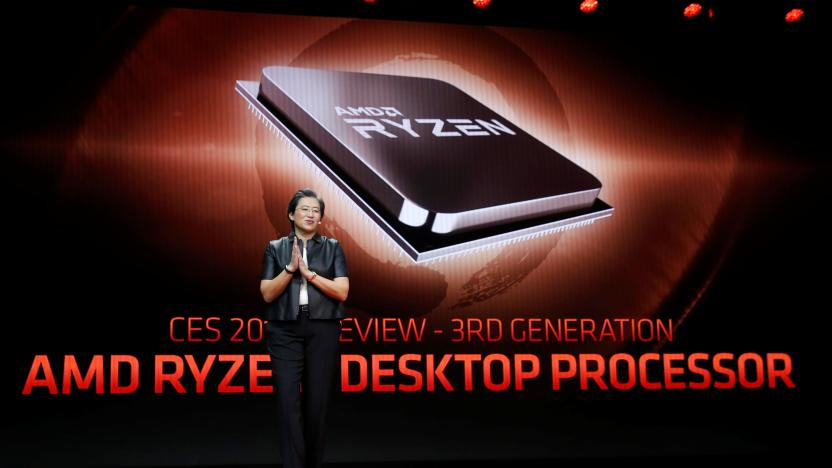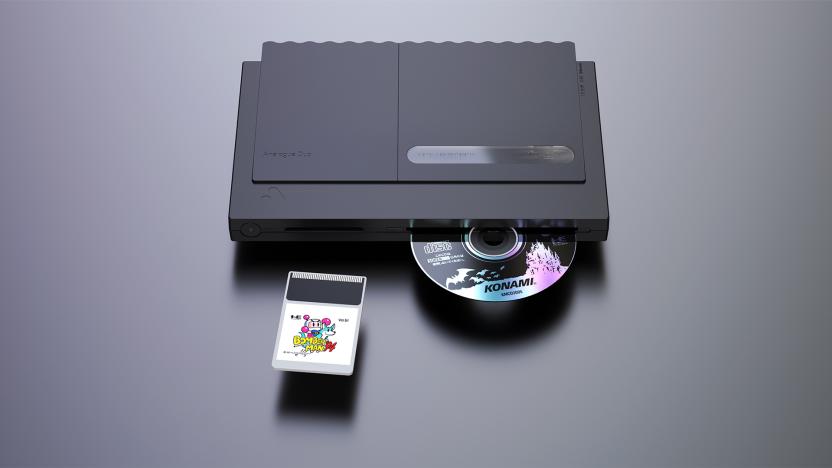fpga
Latest

AMD expands its arsenal by snatching up programmable chip maker Xilinx
AMD is buying Xilinx for $35 billion to give it chip designs it could never have considered before.

Analogue's latest retro dream is an all-in-one TurboGrafx console
The Duo focuses entirely on NEC's home console hardware, offering compatibility with every TurboGrafx-16/PC Engine game produced.

Analogue's portable Pocket console is delayed until May 2021
It's been nine months since Analogue announced the Pocket, a $199 portable console that can play Game Boy, Game Gear, Neo Geo Pocket Color and Atari Lynx games from original cartridges. The console was scheduled to launch in 2020, but Analogue now says, due to the “unfortunate global state of affairs and supply chain challenges," the retro portable will ship in May 2021. The Pocket, like all of Analogue's consoles, is built around a field-programmable gate array (FPGA) chip.

This chip plays ‘Doom’ and nothing else
Sylvain Lefebvre has programmed an FPGA chip to play Doom with 666 lines of code. The chip handles everything except for RAM.

You can build the tiny XFM2 synth for under $100
Miniature electronics kits like the Raspberry Pi have ushered in a new generation of DIY tinkerers. And while most of these builds emulate classic gaming systems, there are plenty of other possibilities. Futur3soundz, for example, designed a synthesizer around an FPGA chip and an Adafruit digital-to-analog converter. The company says that the components can all be purchased for under $100. And while the synth has few on-board controls, it has an extensive MIDI integration, so musicians can control parameters from their keyboards, making it a viable piece of bedroom studio gear.

Microsoft built a hardware platform for real-time AI
In many cases, you want AI to work with info as it happens. That virtual assistant needs to respond within a few seconds at most, and a smart security camera needs to send an alert while intruders are still within sight. Microsoft knows this very well. It just unveiled its own hardware acceleration platform, Project Brainwave, that promises speedy, real-time AI in the cloud. Thanks to Intel's new Stratix 10 field programmable gate array (FPGA) chip, it can crunch a hefty 39.5 teraflops in machine learning tasks with less than 1 millisecond of latency, and without having to batch tasks together. It can handle complex AI tasks as they're received, in other words.

IBM wires up 'neuromorphic' chips like a rodent's brain
IBM has been working with DARPA's Systems of Neuromorphic Adaptive Plastic Scalable Electronics (SyNAPSE) program since 2008 to develop computing systems that work less like conventional computers and more like the neurons inside your brain. After years of development, IBM has finally unveiled the system to the public as part of a three-week "boot camp" training session for academic and government researchers.

Intel lands Altera as its biggest chip manufacturing customer to date
Many of us see Intel as self-serving with its chip manufacturing, but that's not entirely true: it just hasn't had very large customers. A just-unveiled deal with Altera might help shatter those preconceptions. Intel has agreed to make some of the embedded technology giant's future field-programmable gate arrays (FPGAs) using a 14-nanometer process, giving Intel a top-flight customer while giving Altera a leg up over any rivals stuck on less efficient technologies. The pact may be just the start -- Intel VP Sunit Rikhi portrays the deal as a stepping stone toward a greater role in contract chip assembly in an interview with Reuters. We're not expecting Intel to snatch some business directly from the likes of GlobalFoundries and TSMC when many of their clients are ARM supporters, or otherwise direct competitors. However, we'll have to reject notions that Intel can't share its wisdom (and factories) with others.

Blu-ray video encryption cracked using $260 kit
When a master key for HDCP encryption surfaced last year, Intel hardly broke a sweat. It declared that nobody could use the key to unlock Blu-rays or other protected sources unless they got into the semiconductor business and "made a computer chip" of their own. Oh Mann, didn't they realize? That sort of language is like a red rag to a German post-grad, and now Ruhr University's Secure Hardware Group has produced the ultimate rebuttal: a custom board that uses a field programmable gate array (FPGA) board to sit between a Blu-ray player and TV and decode the passing traffic. Student price: €200, and no silly bodysuits required.

Tabula scores $108 million to bring cheap, programmable chips to the masses
If you were to pry open your laptop, microwave or TV you'd find they're all loaded with an array of highly-specialized silicon. Designing, manufacturing, or just purchasing these chips is a major cost for electronics makers. Semiconductor company Tabula, which just secured $108 million in funding to help bring its 3PLD ABAX reprogrammable chips to market, hopes to make these dedicated components a thing of the past. Compared to similarly customizable FPGAs (field programmable gate arrays), Tabula's chips are cheaper, smaller, and faster. This magic trifecta of attributes could put programmable logic into consumer products like HDTVs and may one day allow for hardware to be updated over the internet the way software is now. However, the immediate promise is being able to use the same chip for multiple purposes across several products. That should drive down costs -- and there's no way to make consumers happier than by slashing prices. Full PR and video after the break.

IDT transmit touch information over DisplayPort's auxiliary channel
Still wondering if the future of display linkage really lies in DisplayPort? Hard to say for sure, but IDT's definitely making a good case for it with its latest demonstration. Integrated Device Technology has seemingly figured out how to shuffle touch information through DisplayPort's existing auxiliary channel, which simplifies and lowers the cost of integrating touch technology into tablets, laptops, AIO PCs, monitors, etc. It's being hailed as the world's first usage of the DisplayPort AUX channel to carry touch screen data, and if the prototype proves solid, it'll allow laptop manufacturers to eliminate USB interface communication from host to panel and reduce the number of wires that must pass through the display's hinge. And you know what that means -- slimmer, more flexible designs. IDT's not barking about a release date for its latest trick, but we're guessing it'll have display makers begging for access in no time flat.

Researchers create ultra-fast '1,000 core' processor, Intel also toys with the idea
We've already seen field programmable gate arrays (or FPGAs) used to create energy efficient supercomputers, but a team of researchers at the University of Glasgow led by Dr. Wim Vanderbauwhede now say that they have "effectively" created a 1,000 core processor based on the technology. To do that, the researchers divvied up the millions of transistors in the FPGA into 1,000 mini-circuits that are each able to process their own instructions -- which, while still a proof of concept, has already proven to be about twenty times faster than "modern computers" in some early tests. Interestingly, Intel has also been musing about the idea of a 1,000 core processor recently, with Timothy Mattson of the company's Microprocessor Technology Laboratory saying that such a processor is "feasible." He's referring to Intel's Single-chip Cloud Computer (or SCC, pictured here), which currently packs a whopping 48 cores, but could "theoretically" scale up to 1,000 cores. He does note, however, that there are a number of other complicating factors that could limit the number of cores that are actually useful -- namely, Amdahl's law (see below) -- but he says that Intel is "looking very hard at a range of applications that may indeed require that many cores." [Thanks, Andrew]

Intel providing 22nm fabrication capacity to semiconductor start-up
Well, there sure are interesting things afoot in the land of Intel these days. Just last month the chipmaker announced a $6 to $8 billion dollar investment in factory upgrades to push ahead with hits 22nm manufacturing process, and it's now announced that its struck a first of its kind deal with upstart semiconductor company Achronix. That deal involves Intel actually giving Achronix access to its 22nm fab process, which Achronix will use to manufacture its 22i Speedster FPGAs (said to boast a 300% higher performance and 50% lower power than FPGAs using any other process technology). While that arrangement is notable in and of itself, Intel seems to be going out of its way to downplay the size of the deal. In a blog post discussing the matter, Intel's Bill Kircos notes that the deal "would only make up a tiny amount of our overall capacity, significantly less than one percent, and is not currently viewed as financially material to Intel's earnings." He does add that it is an "important endeavor" for Intel, though, which could possibly suggest that Intel is using the company as a testbed of sorts for its new manufacturing process.

8-bit arcade guitar sounds (and looks) like a little piece of nerd heaven
The hand built, 8-bit "arcade guitar" that you see above is the result of a DIY senior project, and it's a pretty cool accomplishment. There's not a ton of detail about how it was constructed, but we know that it's got an FPGA (field-programmable gate array) for logic and function, strings and a joystick for adjusting the pitch, and it also boasts selectable waves and save banks. Most importantly, however, the final product sounds really, really good -- and we'd advise you to check the video below.

Open-source OGD1 graphics card up for pre-order
Heads-up, open-source gurus -- your next play toy is officially ready to be pre-ordered. The OGD1 is a self-proclaimed "high-end FPGA prototyping kit and hardware engineering platform, equipped with the peripherals needed to develop and test computer graphics architectures." Essentially, it's designed to be used by students of FPGA programming, engineers hunting down a dev platform or hobbyists who just can't stop hacking stuff up. The board itself features twin dual-link DVI outputs, 256MB of RAM, PCI / PCI-X compatibility, a passive cooling system and a 128-bit memory bus. Of course, such a niche product doesn't come without a premium, so don't yell too loudly when reading that this one will cost you $1,500 to take home. Heck, it's only $1,400 if you're one of the first hundred to commit.[Via Hack-A-Day]

Xilinx, Altera showing off FPGA coprocessors at IDF
While Field Programmable Gate Arrays (FPGA) haven't benefited from a good deal of buzz just yet, things could be taking a turn, as both Xilinx and Altera caught a few eyes at IDF. We've already seen the unique, albeit highly specific chips in a supercomputer, but the dedicated coprocessor / accelerator modules could be landing beside your Intel Xeon CPU. Essentially, the devices plug "directly into the processor socket of dual- or quad-socket servers" in order to provide "high performance application acceleration ranging from 10x to 100x compared to processors alone, while simultaneously reducing overall system power consumption." The modules act as targeted CPUs, effectively computing very specific tasks in a much more efficient fashion than a general microprocessor can alone, which could boost the speed of scientific, financial, and life science applications that rely on very particular calculations. Of course, mainstream adoption still has quite a ways to go, but the quicker we get dedicated physics and AI coprocessors to go along with these snazzy new GPUs, the happier (and poorer) we'll be.[Via RobotSkirts]Read - Altera demonstrates FPGA at IDFRead - Xilinx demonstrates FPGA at IDF

University of Edinburgh crafts energy efficient FPGA supercomputer
Considering that ATI and NVIDIA don't seem to be making any substantial strides in reducing the amount of energy required to run their products, it's a tad surprising to hear of an entire supercomputer running a bit leaner than the competition. Hoping on the ever-growing green bandwagon, University of Edinburgh developers are at it again, this time crafting an uber-speedy machine that's reportedly "ten times more energy efficient and up to 300 times faster than its traditional equivalents." Based on field programmable gate arrays (FPGA), the chips are not only very difficult to program, but they can currently only be used "to perform very specific tasks." Of course, the creators are more interested in the extreme number crunching and power saving abilities than anything else, and while no commercial uses have been identified just yet, the machines could purportedly be used in fields such as "drug design, defense and seismology."[Via CNET]

Let It Wave's bandlet upconversion technology on the air in France
Let It Wave's bandlet upconversion technology is on the air on a French high definition TV station broadcasting the French Roland Garros Tennis open. The CTO of France Televisions Interactive states the company is using the technology to mix upconverted SD sources with native HDTV footage, enabling high definition programming to reach customers sooner. We haven't had the best experiences with mixed SD content at US sporting events like the PGA Championship, but Let It Wave claims its technology upconverts as high as 1080p with no flickering or jaggies. French television is currently testing the technology on Altera FPGA-based hardware and will continue to do so for the next three months with a variety of sources, the company plans to announce more products at NAB 2007.

Bandelet upconverting technology finds a home with Altera
That was quicker than we thought. Let It Wave's upconversion technology that claims to be better than current motion-adaptive techniques (like Faroudja's DCDi) has a hardware partner in Altera.Altera has already put their FPGA chips in some devices you may have heard of, like LG's 71" gold plated PDP, RCA's Scenium line of DLP HDTVs and Texas Instruments' DLP chipset. With that track record we should hopefully be seeing this technology in shipping products very soon, especially since the FPGA is designed to be able to change and add new technology quickly.








